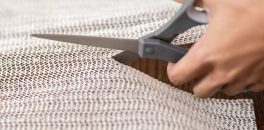Good Posture for Bassists [Best Posture for Playing Bass]

Posture is important because muscle tightness plagues bassists
We most often notice muscle tightness in the neck and shoulder areas or in the lower back.
This has everything to do with the fact that there is a 7 to 15-pound slab of wood often hanging around our necks.
Sure, some basses are lighter but generally speaking, basses nowadays, especially with the prevalence of five-and six-string players, tend to be of weights that suggest bassists will benefit if they really understand the potential risks such weight presents and how that risk gets magnified by poor posture.
One of the most important aspects of playing bass or any other instrument is posture-how you relate to your instrument on a physical level.
I’ve been playing bass for a bit over 7 years, and I noticed that the extensive practice started taking its toll on my back.
Starting out as a bass player, I did not put into mind the proper postures and therefore ended up getting body fatigue.
The bad habits I started when I was young resulted in terrible backaches.
These bad habits went unnoticed because they had become a part of me and I was not adept at interpreting the warning signs and matching symptoms to habits that really needed changing.
My focus on this article is on posture, and how it – and lack of it – can affect bass playing in particular, and everything else you do in general.
READ ALSO: Good Posture While Waving to a Crowd
Here are some of the proper posture tips I have gathered in 5+ years as a pro bassist.
1] Stand up Straight and Wear That Bass Right
First off, let me talk about standing posture.
While I am going to address specific challenges for the bassist in general and electric in particular, these concepts are for everyday life too, as in standing in line or walking down the street.
Taking this advice to heart, when playing or away from the bass, can contribute to the level of comfort and satisfaction you experience while playing.
That in turn typically will improve your overall performance and sound too.
2] Bass Position
For electric bassists, an important consideration is how and where you wear your bass.
Do you wear it high or low?
This is what can often be characterized as a life decision, because how a bassist decides to wear their bass early in life often sticks with them for the rest of their career.
Wearing the bass too high or too low can be equally detrimental, not only to the neck muscles but also to the shoulder and back muscles that support the weight of the instrument.
The risk of wearing a bass too high or too low can also contribute to poorly positioning a bassist’s wrists, which we discussed in last month’s column.
Poorly positioned wrists commonly become overly flexed or extended which causes tendonitis or similar problems.
3] Comfortable Strap
Finding a comfortable strap is equally important. The width and thickness of a strap determine if it will cut into the muscles of the shoulder and cause pain, repetitive stress, and/or nerve compression.
In these cases, the rule of thumb is if it doesn’t feel good, then it isn’t good.
As always, let discomfort be your early warning system.
4] Standing Posture
These concepts are important in gaining a deeper understanding of how your standing posture interacts with the weight of your bass and its position and the impact these combining factors can have on your body.
In a bad situation, the interplay between these factors can cause you to slump forward in an attempt to keep your bass balanced and all the while you are bopping or banging your head back and forth in time to the music.
The results of the combined forces just reviewed are a recipe that promises to serve up an unwanted portion of neck and shoulder muscle tightness, which will carry over when you take the bass off and likely become a permanent part of your physical architecture.
When poor standing posture and improper positioning of your bass compound the muscle tightness in your neck and shoulders, you will probably experience discomfort on a regular basis.
Just as when we slouch on the sofa in front of the television we often feel good.
This is a deception because, in reality, our slouching is keeping muscles tight and causing the bones which they attach to, usually, those of the spinal column, to become restricted and improperly move, causing pain when getting up, walking, or when we are engaged on other normal daily activities.
These negative consequences tend to accumulate and give rise to more pronounced symptoms over the years and are harder to correct as time passes if they are able to be corrected at all.
5] Balanced Body Weight
Another consideration relative to standing posture is balancing your body weight.
It’s easy: try planting both feet firmly and flat on the ground before you begin to play making sure your weight is evenly distributed between both feet.
If you lean to one side or the other, you will generally tend to stay that way and your body will learn to favor that position.
Doing so can result in tilting of the pelvis which affects the muscles of the lower back because incorrect standing posture is putting more strain on one side forcing the body into overworking to support that side.
This situation will force your muscles to overexert themselves to provide the support poor posture now requires.
The overworked muscles will then call on still other muscles to help them out, and before you know it your body thinks this is the way it is supposed to be and you will likely be suffering from chronic muscle tightness.
Typically, you will not experience tightness or pain right away.
Discomfort often starts after poor standing posture has become “normal” to you.
Due to symptoms – i.e. pain often starting well after poor standing posture has become a learned behavior – it becomes harder to both diagnose and change or resolve as poor posture has been adopted as part of your body architecture.
Seated Postural Challenges

Things to check when sitting include music stand height, how you wear the bass, and how you sit with it.
How your sitting posture while playing extends into the “non-playing” part of life, i.e. as you sit in front of the computer, which these days includes a lot of home studio musicians which technology has made commonplace.
When sitting and looking at a music stand, perhaps on a gig, you don’t want to have to crane your neck forward, as this makes the muscles of the neck tighten up and pull on the bones that they attach to in the neck and shoulders.
The neck bones are called vertebrae, and they form the upper part of the neck which is called the cervical spine.
When pulled on by tight muscles, this part of the spine can lose its natural shape, which is a curve in the neck.
Straightening this curve will usually lead to chronic neck-related problems, including neck pain and headaches.
You can minimize risk by avoiding having the music stand too far away, having the music stand poorly lit, sharing it with another player, or having the stand at an uncomfortable height.
Keeping the stand close to you so that you don’t have to strain your neck and having it at a height so that you can read the music at eye level when sitting up straight is optimal.
What’s the Best Way to Sit Up Straight?
When first seated, whether to practice, watch television, eat a meal, surf the net, or any other seated activity slide to the back of the chair and sit straight up with your back to the chair.
You will automatically go into proper seated posture.
Make sure the chair is comfortable and contributes to you in holding the correct posture, instead of overlying on the muscles.
If the chair does not have a flat back and this posture is uncomfortable for the lower back, put a pillow or cushion or rolled-up towel in the small of the back to help maintain the natural curve there (the small of the back is the short curvy part just above the waistline).
This is something jobbing or studio musicians know a lot about because they usually have to deal with lousy chairs.
If there is discomfort in the buttocks, sit on a cushion.
I recommend classical posture and suggest wearing the strap as you would if you were in a standing posture.
This will allow your body to become accustomed to the position of the instrument on your body and allow the instrument to conform to you rather than you having to remodel your posture and your body around it and causing dreaded muscular stress and tightness.
If you rest the instrument on your knee, as the cutouts allow, and like legions of bassists do, it is unnatural.
It only feels natural to us when this is the only way we have ever done it.
Learning new and more healthful sitting posture and bass-wearing techniques will help preserve our health and make playing the bass more enjoyable for years to come.
Classically trained players will use a footstool to help balance the instrument between their knees while sitting.
Some players find this practice strains their lower backs and they often put a cushion under the instrument and plant their feet flat on the floor rather than raising their legs for the footstool.
Using either method, the goal is to balance the pelvis and not put a strain or unnecessary twist in the lower back to avoid any discomfort there.
I suggest you try both ways and see which one works better for you.
Most Importantly,
Whether seated, standing, with the bass, without, walking down the street – whatever – when you feel yourself start to slouch or slump forward, or if slouching feels so natural to you that it’s your default mode, pretend there is a string attached to the top of your head, and this string goes up to the ceiling and pulls you up by the top of your head, as if you were a puppet.
Doing so pulls your head back so that it lines up with your shoulders so your low back automatically straightens maintaining its essential curve.
Now, your shoulders will drop back so you’ll have a beautiful posture for which your body will be thankful.
While you are now in an upright posture, take a deep breath in and let it out all the way, consciously dropping your shoulders at the same time.
You will likely feel your shoulders drop down a couple of inches.
This is the way they are supposed to be. Many of us tend to walk around with our shoulders jacked up high due to stress and tension which is commonly carried there.
It is unnecessary and unwanted and interferes with being the best bassists we can be.
Think about this exercise several times a day.
Make it a priority before and after practice or performance and at various times in your daily routine.
After a while, it will become more natural, like breathing or walking, but at first, you have to be aware of it and treat it as an exercise.
Don’t forget to take a breath in and out and drop your shoulders.
When seated at the computer, everything should be at a 90-degree angle: arms to the keyboard and mouse, and legs out in front of you with feet flat on the floor.
The head should be straight up and in a good seated posture with the top of the monitor at eye level, and close enough to you so that you don’t have to crane your neck forward to see it.
You should also be close to the keyboard and mouse.
Being mindful of these tips will pay dividends when playing your bass because your body and thus playing will not suffer due to problems picked up while working at the computer.
This is a simplified Checklist for a Bassist’s Proper Posture
- Find a good height for your bass, not too high or too low, and use a comfortable strap that does not cut into your shoulder. This will help to take excess pressure off of your hands and wrists, as well as the muscles of your neck, shoulders, and back.
- Make an effort to always plant your feet firmly on the ground when standing, before playing, and avoid putting all of your weight on one side of your body by leaning. This will keep excess strain off of your lower back muscles.
- When seated, sit back in the chair all the way and sit up from there. This will give you a good foundation and keep your spine straight.
- Wear the bass with the strap when seated, and put the bass between your legs classical style rather than on one leg. This will keep you from leaning over the instrument helping you avoid muscle tightness.
- Utilize the string technique as described above to improve postural awareness and keep the spine straight. This will help to avoid problems rather than have to fix them.
- Naturally, I have noticed a lot of my fellow expert bassists seem to disregard or ignore the guidance shared here and they do very well. Some of them do well, and some don’t. Believe me, I have had my share of pains and aches as a result of ignoring these pointers and after decades of playing gig after gig, bad habits tend to take their toll. Better to get into good habits early, or modify current ones to be just a little bit better.
That’s the path to a longer more enjoyable playing life as a bassist.


![Good Posture When You Draw [How to Get the Best Position]](https://www.goodposturehq.com/wp-content/uploads/thumbs_dir/Good-Posture-When-You-Draw-prlnpziekmihpj280qk0337a867a3d3oaq0qc83nbo.jpeg)
![Driving Posture Support [How to Achieve a Good Driving Position]](https://www.goodposturehq.com/wp-content/uploads/thumbs_dir/Driving-Posture-Support-prlmshjh06nlxtpymr9nq1iw2tbcrp420x0rm7rr2s.jpeg)
![Safest Driving Position [And Comfy for Long Trips]](https://www.goodposturehq.com/wp-content/uploads/thumbs_dir/Safest-Driving-Position-prlllxejk8e89fjh5czrts5jsr32925ku9nbd6vgt0.jpeg)
